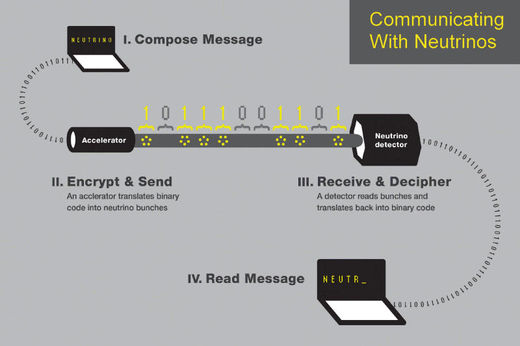Neutrinos cannot replace our use of electromagnetic waves yet because of the need for expensive, high-tech equipment

© University of Rochester
University of Rochester and North Carolina State University researchers have found a way to send messages using a beam of neutrinos, which could eventually eliminate the need for cables or satellites.
Dan Stancil, lead author of the study and professor of electrical and computer engineering at NC State, along with Kevin McFarland, a physics professor at the University of Rochester, and a team of researchers, have successfully sent a message through 240 meters of stone using a beam of neutrinos.
Using neutrinos to communicate wireless messages is not a new idea. Neutrinos are ideal for this task because they are capable of penetrating pretty much any obstacle in their way. They can do this because of their neutral charge and lack of mass, which allows them to not be affected by magnetic attractions or gravity. They can pass through entire planets without being affected while electromagnetic waves, which are used by cell phones, radios and televisions today, are blocked by many objects like water and mountains.
Neutrinos are the better option, but using neutrinos has been difficult because they require large amounts of expensive, high-tech equipment. It isn't practical for use at this point, but Stancil and McFarland are working to make neutrinos an option sometime in the future.
"Using neutrinos, it would be possible to communicate between any two points on Earth without using satellites or cables," said Stancil. "Neutrino communication systems would be much more complicated than today's systems, but may have important strategic uses."
The researchers tested their neutrino system at the Fermi National Accelerator Lab just outside of Chicago, where they had access to the world's most powerful particle accelerators and a multi-ton detector called MINERvA.
The powerful particle accelerators produce high-intensity beams of neutrinos by accelerating protons around a track and crashing them into carbon. MINERvA is a detector found 100 meters underground in a cavern.
Over a two hour period, the accelerator ran at half of its full intensity while MINERvA interaction data was collected as the researchers tested their neutrino beam. The message the researchers sent, which was the word "Neutrino," was translated into binary code. The group of neutrinos being fired were represented by 1's and those not being fired were represented by 0's. Large groups of neutrinos were fired, and they were detected by MINERvA. A computer on the other end then translated the binary back into English, revealing the word "Neutrino."
While this method proved that neutrinos could be a viable alternative to electromagnetic waves, the next step is to find a method of use that doesn't require high-powered, expensive machines.

Reader Comments
to our Newsletter